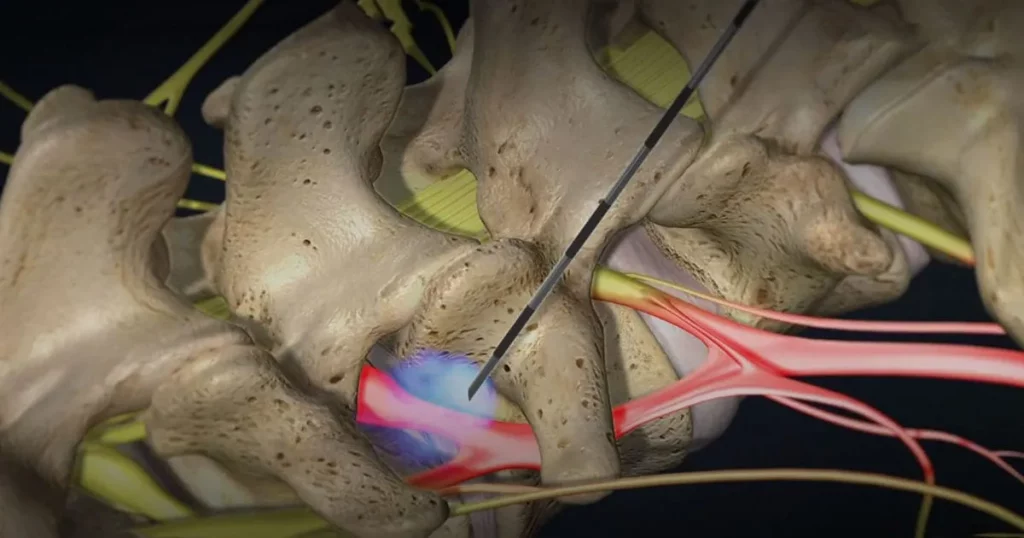Persistent pain plagues plenty of people, prompting the pursuit of powerful relief options. Epidural steroid injections (ESIs) have emerged as a significant strategy for managing chronic back pain, among other discomforts. You’ve likely heard of this treatment, but you may not know the specifics or whether it’s a suitable solution for your situation.
As you navigate the complexities of pain management, understanding the nuances of ESIs—how they work, who benefits the most, and what risks they carry—is crucial. In this guide, you’ll uncover the layers of this procedure and learn how it might fit into your comprehensive pain management plan.
But before you decide if an epidural steroid injection is the next step for you, it’s important to consider the potential complications and the aftercare required to maximize the benefits—a topic we’ll explore in depth to ensure you’re armed with all the necessary information.
Key Takeaways
- Epidural Steroid Injections (ESIs) are minimally invasive treatments that deliver anti-inflammatory medications directly into the epidural space to alleviate pain and reduce inflammation in spinal nerves.
- ESIs are typically recommended for patients with persistent radicular pain who have not responded to physical therapy or medications. They are commonly used for conditions such as herniated discs or spinal stenosis.
- The procedure involves sterilization of the area and local anesthesia, followed by the injection of the steroid near irritated nerve roots. Monitoring for adverse reactions is necessary.
- Potential risks and side effects of ESIs include minor side effects like flushing and increased pain, as well as more serious events like infection or neurological complications. Discussing these risks with healthcare providers is important. Aftercare involves activity limitations, monitoring symptoms, and adhering to prescribed medications. Follow-up appointments are scheduled to assess efficacy.
Everything You Need To Know About Us – Physicians Group, LLC
The expert team at Physicians Group, LLC, a specialized clinic for automobile accident injuries, offers comprehensive care across a network of 27 accessible locations.
TOUCH BASE FOR ASSISTANCE WITH YOUR APPOINTMENT ONLINE
With a widespread presence in regions including Auburndale, Bradenton, Brandon, Palmetto, Ft Myers, Jacksonville Beach, Jacksonville, Orange Park, Lakeland, Clearwater, New Port Richey, Port Charlotte, Sarasota, Sebring, Spring Hill, St. Petersburg, Tampa, Temple Terrace in Florida, as well as Brooklyn Park, Robbinsdale, Minneapolis, Richfield, and St Paul in Minnesota, Physicians Group, LLC is a prime destination for addressing injuries post-automobile accidents.
Our Expertise
Endorsed by The Joint Commission, Physicians Group, LLC stands as a comprehensive hub for the treatment of musculoskeletal injuries. Its multidisciplinary team comprises seasoned medical doctors, skilled chiropractors, osteopathic professionals, attentive nurse practitioners, and proficient physician assistants.
The group is adept at managing a spectrum of musculoskeletal discomforts, from joint, back, to neck pain. By leveraging state-of-the-art technology and diagnostic tools like DynaROM™ motion testing, digital motion X-rays (DMX) for the cervical spine, and cutting-edge regenerative therapies, they are equipped to foster optimal recovery.
Emphasizing a nurturing, patient-focused atmosphere, the dedicated personnel at Physicians Group, LLC ensures thorough consultations and in-depth discussions, allowing them to grasp every patient’s specific complaints and aspirations fully. Treatment plans emphasize non-invasive and integrative approaches, with surgical interventions being considered as necessary.
Don’t allow the aftermath of vehicle accidents to impede your lifestyle. Initiate your path to recovery at Physicians Group, LLC by reaching out to your local branch or by securing an appointment through our online platform.
Our Services:
Contact Us:
→ https://physiciansgroupllc.com/contact-us/
Understanding Epidural Steroid Injections
Epidural steroid injections (ESIs) are a minimally invasive treatment option that involve the targeted delivery of anti-inflammatory medications directly into the epidural space to alleviate pain and reduce inflammation in the spinal nerves.
As you consider this option, it’s important to understand that ESIs are typically indicated for patients with radicular pain, which is pain that radiates from the spine to an extremity. This modality is often recommended when conservative treatments like physical therapy or oral medications haven’t provided adequate relief.
Steroids used in ESIs—corticosteroids—are potent anti-inflammatories. They work by suppressing the immune response, thereby decreasing swelling and attendant nerve irritation. The precision of this intervention is crucial; fluoroscopic guidance ensures accurate placement, minimizing risks and maximizing therapeutic outcomes.
Ideal Candidates for ESIs
When determining the suitability of patients for epidural steroid injections (ESIs), those experiencing persistent radicular pain despite conservative treatments are often considered prime candidates. The selection process leans on evidence-based criteria to identify individuals who may benefit from this intervention:
- Persistent Radicular Pain
- Unresponsive to physical therapy or medications
- Resulting from herniated discs or spinal stenosis
- Diagnostic Confirmation
- MRI or CT scan indicating nerve root compression
- EMG supporting radiculopathy diagnosis
You must exhibit specific clinical symptoms correlating with imaging studies that confirm nerve root compression. ESIs are typically not the first line of treatment but serve as a pivotal option when less invasive methods don’t suffice. It’s crucial to have a comprehensive evaluation by a healthcare professional to ensure ESI is appropriate for your condition.
The Procedure Explained
How does an epidural steroid injection (ESI) alleviate pain? Administered directly into the epidural space, the ESI delivers potent anti-inflammatory medication near the irritated nerve roots. This targeted approach reduces inflammation and swelling, offering relief from pain. It’s a minimally invasive procedure that can provide significant respite from chronic spinal conditions.
Here’s a concise table to break down the key aspects of the process:
| Step | Purpose | Duration |
| Preparation | Sterilize the area; local anesthesia | 5-10 minutes |
| Injection | Deliver steroid to the epidural space | 1-2 minutes |
| Observation | Monitor for adverse reactions | 15-30 minutes |
Potential Risks and Side Effects
While epidural steroid injections are generally safe, they do carry a small risk of complications that can range from minor, transient side effects to more serious adverse events. It’s essential to understand these potential risks before proceeding with treatment.
Here’s a breakdown:
- Minor Side Effects
- Transient:
- Flushing
- Increased pain for a few days
- Insomnia
- Elevated blood sugar levels
- Transient:
- Serious Adverse Events
- Infection:
- Risk of epidural abscess
- Meningitis
- Neurological Complications:
- Dural puncture headache
- Nerve damage
- Paralysis
- Infection:
Each risk carries different likelihoods and outcomes. It’s critical to discuss these with your healthcare provider to weigh the benefits against the potential for harm accurately.

Aftercare and Recovery Process
Understanding the potential risks and side effects of epidural steroid injections is crucial, but it’s equally important to know what to expect during the aftercare and recovery process to ensure optimal healing and pain management.
| Aftercare Instruction | Details |
| Activity Limitations | Avoid strenuous activities for 24 hours post-injection. |
| Pain Monitoring | Track pain levels and any changes in symptoms. |
| Ice Application | Apply to injection site to reduce inflammation if advised. |
| Medication Adherence | Take any prescribed medications as directed. |
| Follow-up | Schedule and attend follow-up appointments to assess efficacy. |
Adhering to these aftercare instructions can significantly affect the outcome of the injection. It’s imperative to monitor your pain and report any unusual changes to your healthcare provider. Your recovery is a partnership between you and your medical team, guided by clinical expertise.
Frequently Asked Questions
How Do Epidural Steroid Injections Compare to Other Pain Management Options, Like Physical Therapy or Oral Medications, in Terms of Efficacy and Long-Term Benefits?
You’ll find that epidural steroid injections can offer quicker pain relief than physical therapy or oral meds, but they don’t typically provide the long-term benefits that come with consistent, rehabilitative therapies.
Can Lifestyle Factors, Such as Diet and Exercise, Influence the Effectiveness of Epidural Steroid Injections for Pain Management?
Yes, your diet and exercise habits can impact the effectiveness of epidural steroid injections. Healthy choices may enhance outcomes by reducing inflammation and improving your body’s response to the treatment.
Are There Any Psychological Effects or Impacts on Mental Health Associated With the Use of Epidural Steroid Injections for Chronic Pain?
You may experience mood swings, anxiety, or depression as psychological effects from epidural steroid injections for chronic pain, likely due to the corticosteroids affecting your hormonal balance and brain chemistry.
How Does the Presence of Underlying Conditions Like Diabetes or Autoimmune Diseases Affect the Decision to Use Epidural Steroid Injections for Pain Relief?
You’ll need to consider how diabetes or autoimmune diseases could influence your response to epidural steroid injections, as they may alter drug efficacy or increase the risk of side effects.
Is There a Limit to the Number of Epidural Steroid Injections a Person Can Receive Over Their Lifetime, and What Are the Implications of Exceeding This Limit?
You’re typically limited to three to four epidural steroid injections per year to minimize side effects. Exceeding this can increase the risk of bone density loss and hormonal imbalances.
Conclusion
In conclusion, you’ve learned that epidural steroid injections (ESIs) can be a pivotal part of your pain management strategy. They’re best suited for those with inflammatory conditions affecting the spine.
Remember, while the procedure is generally safe, you may encounter side effects. Following your doctor’s aftercare instructions is crucial for a smooth recovery.
Trust in this evidence-based intervention to potentially alleviate your discomfort and enhance your quality of life.
